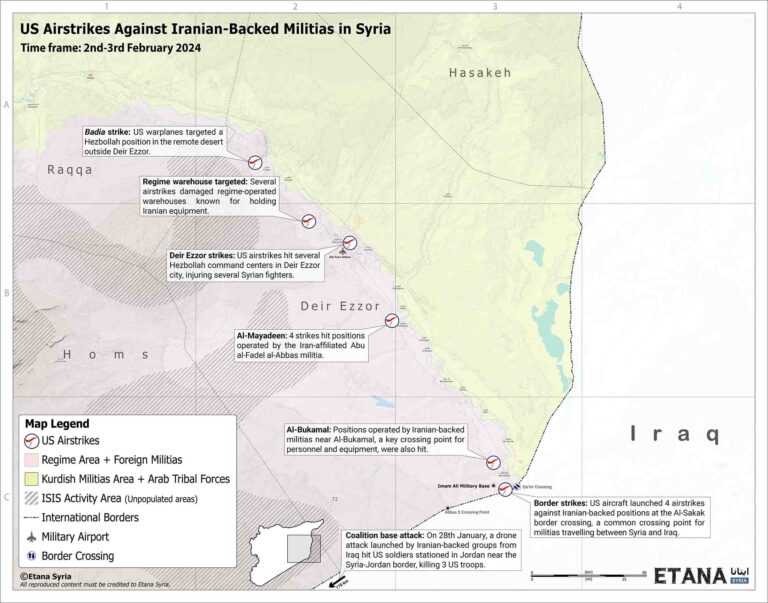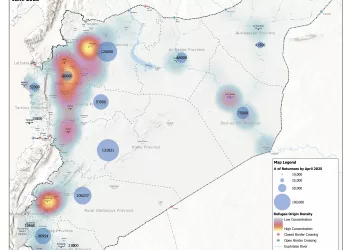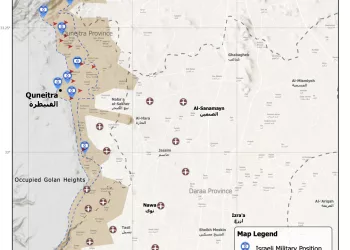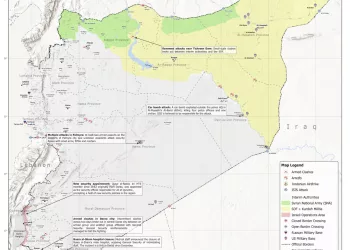The US launched a sweeping aerial bombardment campaign between 2nd-3rd February, striking at least 85 Iranian-linked militia targets across Iraq and Syria. The strikes are said to be the first step in Washington’s retaliation for an Iranian-backed militia attack that killed three American soldiers in late January. Though the airstrikes mark a major US escalation against Iranian-backed militias in the region, their impacts may be limited. The initial aftermath of the US strikes suggests that a delayed start to the bombardments gave Iranian proxies ample time to remove both personnel and material from strategic positions and evacuate fighters. Initial casualty reports indicate that of the 11 confirmed dead in these attacks, the majority were local Syrian fighters. The threat of continued airstrikes may temporarily discourage overt Iranian activity and dissuade its militias from redeploying openly for a time, but the bombings have not significantly diminished Iran’s strategic operational capacity or entrenchment in Syria.
Attached Map:
US Airstrikes against Iranian-Backed Militias in Syria
(For a high-resolution version of this map, please use the form at the bottom of the page)
Militias Prepare for Retaliation
On 28th January, an armed drone launched from Iraq by an Iranian-backed militia targeted Jordanian Border Post 22, along the Syrian-Jordanian border. Three US troops were killed as a result and at least 34 were reported injured. Officials in Washington vowed that a retaliation was coming: the day after the attack, Secretary of State Antony Blinken stated that the US would “respond strongly” at “a time and place of our choosing.” The 2nd-3rd February attacks represent a first step in the US’ stated plans for retaliation. Immediately following the 28th January attack, Iranian-backed militias began preparing for an imminent US response, with foreign and local militia elements evacuating positions deemed to be under threat and redeploying their forces to other areas of Syria.
US Airstrikes
Preliminary reports indicate that US warplanes targeted more than a half dozen positions in eastern Syria, killing at least 11 and wounding 18 others. Of the confirmed fatalities, the majority were Syrian fighters. Further reporting by independent outlets and international media suggest that several dozen fighters were killed in the airstrikes, but ETANA could neither independently verify these reports nor ascertain a comprehensive death toll.
In Deir Ezzor city, US forces hit several Iranian-backed militia sites, destroying the regime-operated Ayash warehouses, which wereknown storage facilities for Iranian weapons and equipment. Additional airstrikes targeted Hezbollah command centers, injuring several Syrian fighters. At least four airstrikes targeted parts of Al-Mayadeen, a hotspot of Iranian-backed militia activity located along the Euphrates River south of Deir Ezzor city. US warplanes also struck several positions operated by Iranian-backed militias near al-Bukamal. Strikes also hit the Al-Sakak border crossing, which is used as a militia crossing point between Syria and Iraq.
Aftermath
The recent US strikes in Syria have had limited effect. For now, Iranian-backed militias in Syria are still taking precautions against further US strikes, especially those positioned near Al-Bukamal and Al-Mayadeen in Deir Ezzor. Groups expect that the US retaliation will be short-lived and anticipate returning to regular activities soon.
The US airstrikes may, at best, temporarily disrupt Iranian-backed militias’ regular operations. But in the long-term, Iran’s entrenchment in Syria is crucial to its regional ambitions, not least by providing it with frontlines against US forces. Iran’s tit-for-tat with the US has already continued: days after the US airstrikes, Iranian-backed militias launched an overnight drone strike targeting a base in the Al-Omar oilfield housing both US and Syrian Democratic Forces (SDF) troops, killing six SDF members.






